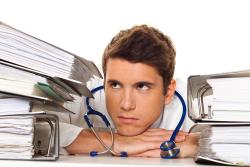 From the Affordable Care Act (ACA) to statewide reform initiatives, the pressure is on for healthcare providers to offer maximum quality healthcare to increasing patient populations at a more affordable rate.
From the Affordable Care Act (ACA) to statewide reform initiatives, the pressure is on for healthcare providers to offer maximum quality healthcare to increasing patient populations at a more affordable rate.
 From the Affordable Care Act (ACA) to statewide reform initiatives, the pressure is on for healthcare providers to offer maximum quality healthcare to increasing patient populations at a more affordable rate. Couple this with pressure to integrate healthcare, increase communication, ensure privacy, and reduce risk and you have a pressure cooker of factors that are driving Healthcare providers to find fast, sustainable solutions. One of those solutions is the application of predictive modeling. In today’s post we will talk a bit about how predictive modeling has the capability to help healthcare solve some of its biggest challenges. We will review what exactly predictive modeling is, how it can be applied to healthcare, and how it is already working for some in the field. Let’s get started!
From the Affordable Care Act (ACA) to statewide reform initiatives, the pressure is on for healthcare providers to offer maximum quality healthcare to increasing patient populations at a more affordable rate. Couple this with pressure to integrate healthcare, increase communication, ensure privacy, and reduce risk and you have a pressure cooker of factors that are driving Healthcare providers to find fast, sustainable solutions. One of those solutions is the application of predictive modeling. In today’s post we will talk a bit about how predictive modeling has the capability to help healthcare solve some of its biggest challenges. We will review what exactly predictive modeling is, how it can be applied to healthcare, and how it is already working for some in the field. Let’s get started!
What Is Predictive Modeling?
Predictive modeling is essentially a way to take specific data sets and utilize them to predict future trends. Predictive modeling is currently utilized in many facets of business, and is employed as a regular part of our day to day lives, even if we do not realize it. Companies use predictive modeling to determine when the best time to run an advertisement for their product on television is using predictive modeling that takes into account their target demographic. Life insurance companies utilize predictive modeling taking into account someone’s age and lifestyle to determine what their premium would be. We even use predictive modeling ourselves on a daily basis predicting future outcomes based on our current actions, taking into account what past outcomes those actions have yielded.
Predictive modeling can be simple or robust, in the case of healthcare, the new age of Big Data is allowing for robust predictive modeling that can influence a variety of quality and cost improvement factors. Big Data, which is essentially large pools of data spread over diverse regions and patient populations and monitors several variables over a long period of time, is allowing for extremely complex predictive models to be developed. The more complex the model, the more likely it is to accurately predict a future event.
How Can Predictive Modeling Help Healthcare?
The ways in which predictive modeling has the capacity to help healthcare are nearly limitless, but large impacts and areas of particular focus can include cost reduction, improvement of patient outcomes, and the improved design of clinical interventions to positively impact care.
Reducing Healthcare Cost
One of the big areas of concentration in healthcare currently is cost reduction. Predictive modeling is already being utilized in some instances to determine prospective payments to providers in the Managed Care arena. In this case historical data is utilized to determine what the standard cost of care per member per month has been historically for a particular patient population, in this case the Medicaid population. In this case the State can then set a payment rate to Managed Care Organizations which allows for a specific dollar amount to cover the care of the patients in their area on a per member per month basis. This payment amount can also be utilized as a baseline which the Managed Care Entity can use to determine if specific interventions with this patient population decrease the cost of care over time. For instance, if a Managed Care Entity is allotted 895.00 per member per month to provide care, and then applies an intervention to a segment of their population, such as coordinated disease management for those patients with costly or complex cases, they then have a historic benchmark by which to compare if overall cost of care has gone down for this population using the new intervention. Of course, this is a simplified example, in actual predictive modeling there are several complex variables and binaries examined to determine the dependent outcome. Patient care is complex, and thus the predictive model that can impact a specific outcome is equally complex.
Improving Care Outcomes
Another ambitious way in which healthcare will be able to benefit from predictive modeling is in the improvement of patient outcomes. Models which are capable of doing this are still few and far between due to a lack of large data, however this area will offer great opportunity in the future which may be facilitated by Big Data and EHR implementation. Predictive modeling for clinical outcomes will essentially allow healthcare providers to monitor patient outcomes by taking into account specific patient factors. For instance, a patient population can be examined based on a chronic condition, in this example we will use depression. The predictive model can take into account patient factors such as age, severity, gender, primary diagnosis, etc. and see what correlation there is with the onset, worsening, or development of depression. Going a step further predictive modeling can provide statistics on what has worked to most effectively treat depression from a care perspective, and can indicate optimal care for specific patients based on historic data to elicit the optimal outcome. This allows organizations to impact care through the following:
- creation of best practices based on historic data and outcomes
- care planning and coordination based on predictive modeling analysis
- allocation of care resources to achieve best outcomes (for instance, if longer treatment times do not impact overall outcome, but more intense sessions do this can be utilized as a best practice. Another example would be level of care, if predictive modeling indicates that patients receive no added benefit from being treated at a higher level of care, and optimal outcomes can be achieved in a lower level of care, then cost saving can result simultaneous to improved outcomes)
How you dice and splice the data will yield almost infinite potential for healthcare improvement across the continuum, and the utilization of predictive modeling, a data based solution, can solidly inform how healthcare providers can continue to enhance their efforts toward continuous quality improvement and cost reduction.
If Predictive Modeling Is So Helpful, Why Hasn’t It Been Utilized More?
If predictive modeling is so helpful to healthcare why hasn’t it been utilized before now? The answer is simple. Until recently the large subsets of data needed to create the complex models required to accurately predict change have been previously unavailable. Paper records, instead of electronic health records (EHRs) meant that information was segmented between practices, and data bases were unavailable. Furthermore, much of the information needed to do a deeper dive into complex modeling has only recently began to be gathered by healthcare organizations. We are now, with the advent of EHRs and big data just beginning to have enough of the crucial information available to allow for complex predictive modeling to take place. As data is continuously gathered, which is more robust, and gathered over longer periods of time, our ability to apply predictive modeling to healthcare will continue to increase. This is certainly an areas of healthcare improvement that should be worked toward in the present and monitored in the future for its ability to dramatically improve the cost and quality of healthcare.








